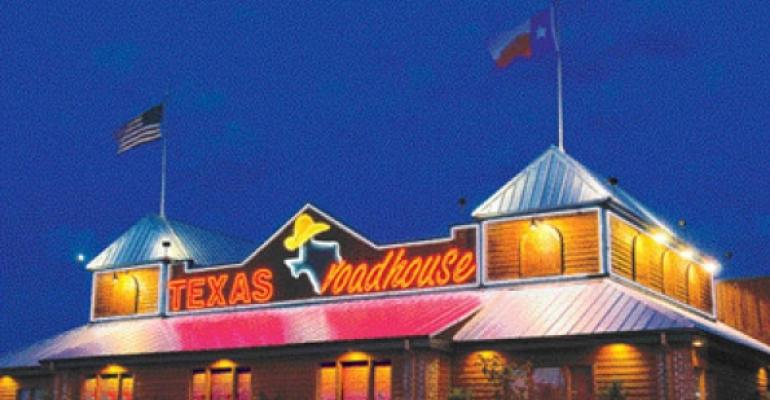Texas Roadhouse Inc., which operates or franchises 360 restaurants, expects to open at least 25 new locations in 2012, and to drive a same-store sales increase of between 4 percent and 5 percent, the company said Wednesday.
Commodity inflation is expected to be the biggest hurdle for the Louisville, Ky.-based brand in the coming year, officials said, as they project food costs to increase 8 percent in 2012. During the brand’s fourth-quarter earnings call, executives laid out pricing and menu mix strategies to offset some of that inflation.
The chain completed the systemwide rollout of a 2.2-percent menu price increase in early February, and introduced a 23-ounce porterhouse steak in about one-third of its locations.
“We do expect the cost side of our business to be challenging,” said founder and chief executive Kent Taylor. “In spite of recent pricing actions, we do not expect to completely offset the effect of 8-percent food cost inflation. In other words, we are going to balance short-term profit pressures with protecting the long-term positioning of our concept. We believe this discipline has served us well in the past and will continue to do so in the future.”
The company expects to open 25 company-owned locations in 2012. Executives are optimistic that Texas Roadhouse could open a few more locations in the Middle East this year — its first international franchise opened last summer in Dubai, United Arab Emirates — and eventually restaurants in Mexico, Canada, Russia and China.
“We believe the demand exists for many more Texas Roadhouse restaurants,” said brand president Scott Colosi, “and we are seeing great new-store performance from both the sales and cost sides, which make us feel encouraged about continuing to increase our unit growth on an annual basis.”
Taylor noted that 2012 began with a “solid start,” with same-store sales increasing 6.7 percent for the first seven weeks.
The right price for positioning
Texas Roadhouse’s projection for same-store sales growth of between 4 percent and 5 percent this year assumes a 3-percent impact from menu price increases — including the 2.2 percent just taken, plus some carryover from last year — and about 1 percent to 2 percent of traffic growth, said chief financial officer Price Cooper.
“Two percent [recently taken] is a number that we are comfortable with competitively,” Colosi said. “We have to think about what inflation we have, but we also have to think in terms of what’s going on competitively and what we think our concept can bear.”
The brand has no tests of further price increases planned, Cooper said. He added that the company has about 90 percent of its beef costs for 2012 locked in.
“We’ve been very focused at executing our food and service at a very high level,” Colosi said. “We still scream a lot of value on our menu. That continues to bring in our guests as well. So we’re very well positioned right now, and we think it shows in our results. We continue to maintain a lot of value on our menu that I think is as competitive, if not more, than the majority of our competitors.”
Porterhouse addition bolsters high end
Taylor said the new 23-ounce porterhouse steak “provides additional variety for our guests willing to spend more money, just like the bone-in rib eye we added to the menu last year.”
The brand has yet to procure enough supply for the porterhouse to roll it out to the remaining two-thirds of its system, Taylor added.
Texas Roadhouse drove a 2.3-percent increase in its average check in the fourth quarter, contributing to a 5.7-percent increase in same-store sales. Colosi and Cooper added that the higher-price items, plus a price increase taken in the brand’s alcohol offerings, may drive a mix shift toward lower-margin dishes this year, but expected traffic gains between 1 percent and 2 percent should help drive overall sales.
“We’re optimistic that there are folks out there that have the demand for some of the higher-price stuff and that they’ll continue to buy it,” Colosi said.
The chain also would increase its capital expenditures slightly this year not only to build new restaurants, but also to increase efficiencies in existing locations, where speed of service and table turns remain crucial.
“Our operators continue to challenge themselves on the speed initiatives and how to increase the opportunity for more through-put in the restaurants,” Cooper said. “On top of that we continue adding seats in restaurants — we’re up to just shy of 70 restaurants where we’ve added seating.”
The chain has been testing a few different host systems that would allow for call-ahead seating, but it ended its test of tableside payment systems.
Contact Mark Brandau at [email protected].
Follow him on Twitter: @Mark_from_NRN





